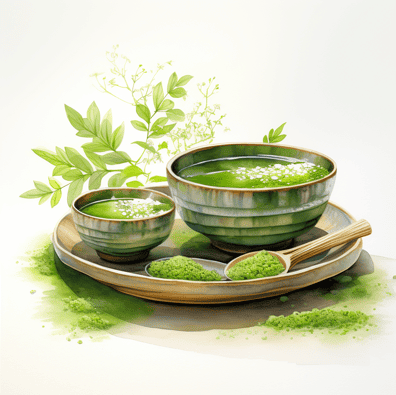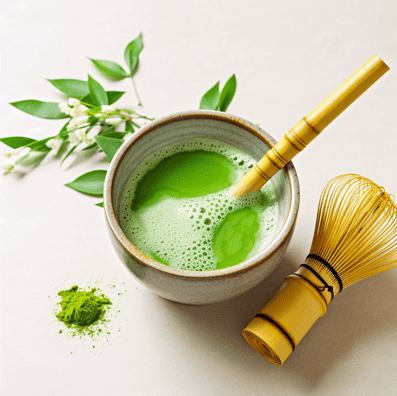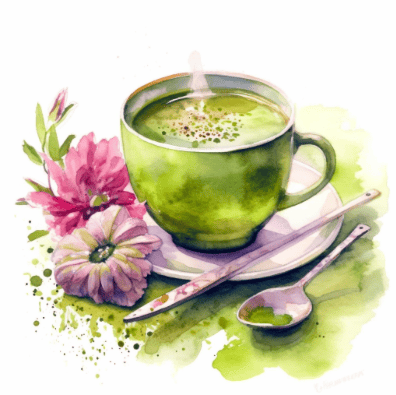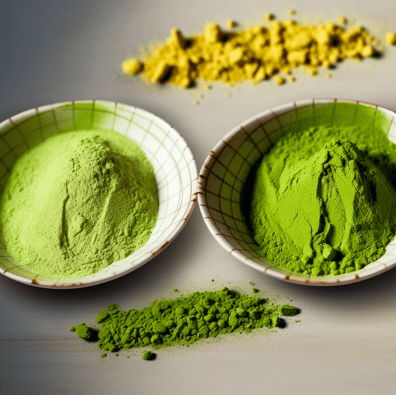
Don’t want to read the whole post?
With so many types of matcha available, from ceremonial grade matcha and culinary matcha to premium matcha, it can be difficult to figure out which matcha is the best for you.
Look out for a vibrant colour and a fresh vegetal aroma. Be wary of cheaper matcha, which is often lower quality.
ABOUT ME
Be beauty. Be plant-based!
As a former Registered Nurse and avid plant-muncher, I’m in love with how simple plant-based foods make it so easy to be beautiful.

You might also like:
To Sip or to Whisk? Hojicha vs Matcha Japanese Tea
Amelie, a curious and health-conscious woman, wants to understand the difference between good matcha vs bad matcha. She’s committed to developing a healthier lifestyle. However as there are so many, many brands and types of matcha to choose from, she’s worried about making the wrong choice. She does’t want to waste her money or risk her health with a low quality matcha.
Skip to: Understanding the Importance of Tea Quality: Impact on Health Benefits
Wanting both the authentic taste and optimal health benefits of matcha, Amelie educates herself about the various factors determining the quality of matcha. She learns that good matcha is made from high-quality green tea leaves, carefully harvested from the first flush or early stages of growth. These leaves are responsible for the more vibrant green hue of higher quality matcha. They possess a rich nutrient profile which contribute to the distinctive flavour of matcha.
Skip to: The Characteristics of Good Matcha: Aroma, Colour, and Texture
Amelie also discovers the significance of organic matcha, which is produced without the use of synthetic fertilisers or pesticides. Enjoying a purer, more natural product resonates with her commitment to a healthy lifestyle and respect for the environment. She makes a mental note to look for certified organic matcha powders for her future purchases.

As Amelie delved deeper into authentic matcha preparation, she discovered the best way was to use a bamboo whisk (chasen). This traditional tool was essential in achieving the desired texture and frothiness of the matcha, and another important aspect of developing a high quality matcha experience. It was also very important to only buy Japanese matcha, which is higher quality. Armed with this knowledge, she eagerly anticipated the moments if indulging in a cup of freshly whisked matcha or savour a creamy matcha latte.
Amelie also learned that the best matcha powders possess a vibrant green hue and a fresh grassy aroma. Also, a fine, silky texture.
Skip to: The Role of Green Tea Leaves: How They Influence Matcha Quality
Amelie’s exploration of good matcha versus bad matcha expanded her knowledge and her appreciation for this special green tea powder. With a fuller understanding, she now confidently selects the best matcha powders within her budget. This ensures that every sip is both a delightful, healthful and economical experience.

A beautiful matcha in the morning is such a good thing!
Skip to: Identifying the Warning Signs: Red Flags of Low-Quality Matcha
With so many types of matcha available, from ceremonial grade matcha and culinary matcha to premium matcha, it can be difficult to figure out which matcha is the best for you.
This can be a big decision, trying to find the right kind of matcha for you. Matcha has many significant health benefits so it’s important to buy the best quality matcha you can afford.
Discover what you need to know before choosing your next batch of umami matcha.
The Characteristics of Good Matcha
When assessing the quality of matcha, there are several key characteristics to keep in mind. Aroma, colour, and texture.
Aroma
The aroma of matcha is a window into its quality. Good matcha exhibits a vibrant and fresh vegetal scent, reminiscent of freshly harvested green tea leaves. It’s a pleasant and invigorating fragrance which is a testament to the careful cultivation and processing methods employed. In contrast, lower quality matcha may have a muted or even stale aroma.
Colour
The colour of matcha is a visual representation of its quality and freshness, and an obvious tell-tale sign to look out for. Look for a bright green powder. High quality matcha is made from the tea leaves grown in shaded conditions away from direct sunlight before harvesting, which promotes the production of chlorophyll. This is what produces the characteristic bright green colour or matcha.
In contrast, lower quality matcha tends to have a duller or more yellowish-green colour, indicating inferior tea leaves or improper processing.

Texture
Texture plays a crucial role in the overall matcha experience, and an important sign of matcha quality. Good matcha should have a fine and silky texture of the powder, akin to talcum powder. This fine particle size ensures that the matcha powder dissolves easily and uniformly when whisked with hot water. It contributes to mouthfeel, allowing for a velvety and smooth taste. In contrast, lower quality matcha may have a coarser texture, resulting in a grainy and less enjoyable drinking experience.
Whether you want to enjoy a traditional cup of matcha or incorporate it into your culinary creations, understanding these characteristics help to make informed choices to fully appreciate this exceptional tea.
Matcha Health Benefits: The Importance of Quality Tea
The quality of this finely ground powdered green tea plays a significant role in unlocking its potential health benefits.
The cultivation and processing methods used in producing matcha can significantly affect its quality and nutrient content. High-quality matcha is typically made from young tea leaves that are shade-grown before harvesting. This shading process boosts the chlorophyll production in the leaves, resulting in vibrant green colour and increased amino acid content.
Good quality matcha is packed with essential nutrients and antioxidants. It contains a high concentration of catechins, particularly epigallocatechin gallate (EGCG), which is known for its potent antioxidant properties. These antioxidants combat free radicals in the body, reducing inflammation, and contributing to overall well-being.
In contrast, lower quality matcha may have reduced levels of these beneficial compounds, diminishing its potential health benefits.
By choosing good quality matcha, you choose a product that offers the maximum health benefits. Its high levels of antioxidants, amino acids, and nutrients can support immune function, promote detoxification, enhance cognitive function, and even aid in weight loss. Prioritise matcha that undergoes strict quality control measures and is sourced from reputable producers to ensure you’re reaping the full potential of its health-boosting properties. It’s also preferable to source matcha that’s organic.
You might also like: Matcha Magic: The Power of Green Tea for Acne-Free Skin
How Tea Leaves Influence Quality
When it comes to matcha, the quality of the green tea leaves used plays a vital role in determining overall quality of the matcha powder.
First, there is selection of tea plants and the harvesting process. Matcha is typically made from specific green tea plants, specifically Camellia sinensis. These plants are chosen for their desirable characteristics, including their ability to produce tender, young leaves that are rich in flavor and nutrients.
The timing of the harvest also plays a significant role. Harvesting the leaves at the right stage of growth ensures optimal quality and taste. Matcha is often made from the first flush, which refers to the first harvest of the year, usually in late April. At this time, the tea leaves are tender, vibrant green, and packed with nutrients, making them ideal for producing premium matcha.
Another crucial factor is the shading process. Prior to harvest, the tea plants used for matcha production are shaded for several weeks. This stimulates the green tea plants to produce higher levels of chlorophyll, resulting in the vibrant green color characteristic of matcha. The shading process also enhances the concentration of amino acids, particularly L-theanine, which contributes to matcha’s unique flavour profile and soothing effects.
Finally, the way the green tea leaves are processed after harvest is important. The leaves undergo careful steaming, drying, and grinding to transform them into a fine powder. This grinding process, done with traditional stone mills, creates the distinctive fine texture of matcha powder. The gentle grinding minimises heat generation, ensuring that the valuable nutrients and flavours of the tea leaves are preserved.
The Matcha Grading System
Ceremonial Grade vs Culinary Grade Matcha
When it comes to choosing your matcha, understanding the different grades of matcha is good to understand. The grading system categorises matcha into different grades based on various factors such as taste, colour, aroma, and intended use. Two common grades of matcha that you’ll come across are ceremonial grade matcha and culinary grade matcha.
Ceremonial matcha is considered the highest quality matcha and is often used in traditional Japanese tea ceremonies. It is made from young tea leaves that are carefully cultivated and harvested, ensuring a bright green colour and delicate flavour profile. Ceremonial matcha powder is characterised by a smooth and mellow taste, with a slight sweetness and vegetal notes. It’s fine texture allows it to dissolve easily in hot water, resulting in a frothy and visually appealing cup of matcha. Due to its exceptional quality, ceremonial grade matcha is usually more expensive compared to other grades.
On the other hand, culinary grade matcha is more commonly used for cooking, baking, and making matcha-based beverages such as lattes. It is made from slightly older tea leaves and may have a slightly bitter taste compared to ceremonial grade matcha. Culinary grade matcha also has a slightly coarser texture, which makes it suitable for blending into recipes. It may not have the vibrant green colour or delicate flavour of ceremonial grade matcha, but it still offers a pleasant green tea taste and retains some health benefits. Culinary grade matcha is more affordable and readily available, making it a popular choice for those who want to incorporate matcha into their daily routines.
You might also like: Ceremonial vs Culinary Matcha: Which is Right for You?
Red Flags for Low-Quality Matcha
While good quality matcha can offer a delightful and authentic experience, it’s important to be aware of the warning signs that indicate poor quality matcha. Avoid wasting your money on subpar matcha products and ensure that you’re getting the best possible matcha experience with the indicators of bad matcha below.
Could is the first sign of a good or bad matcha powder. Good quality matcha should have a vibrant and vivid green colour, reflecting its high chlorophyll content. If the matcha powder appears pale or yellowish, it’s likely an indication of lower quality or improper processing.
Also be mindful of the aroma. High-quality matcha has a fresh and vibrant vegetal scent, reminiscent of freshly cut grass or steamed greens. On the other hand, low-quality matcha may have a dull or stale smell, indicating that the leaves used in its production were not of the highest quality or were poorly processed.
You might also like: The Best of Both Worlds: Chai Matcha Latte
Texture is another important factor. When you rub a small amount of matcha powder between your fingers, it should feel silky and smooth, indicating a finely ground powder. If the texture feels gritty or grainy, it suggests that the matcha was not ground properly, resulting in an inferior product.
Lastly, pay attention to the price. While it’s not always the case, excessively low prices can be a warning sign of low quality matcha. Producing high-quality matcha requires careful cultivation, harvesting, and processing techniques, which come at a cost. If the price deal seems too good to be true, this could be the first ‘tell’ in determining good matcha vs bad matcha.
By keeping these warning signs in mind and being attentive to the aroma, colour, texture, and price, you can become a discerning matcha consumer and ensure that you’re investing in the best quality matcha that will truly elevate your matcha experience.